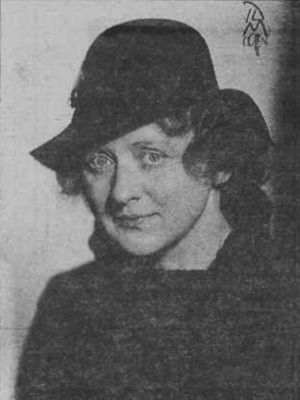Ingeborg Wærn Bugge facts for kids
Ingeborg Wærn Bugge (born March 5, 1899 – died January 26, 1991) was a famous Swedish architect. She was one of the very first women in Sweden to get a proper education in architecture. Ingeborg designed homes and schools, and also helped restore old churches.
About Ingeborg Wærn Bugge
Ingeborg was born in Oslo, Norway. Her father was a shipowner. When she was young, her parents divorced. She moved with her mother and brother to Gothenburg, Sweden, in 1902, and later to Stockholm.
She was a very bright student! In 1918, she finished her high school education with excellent grades in subjects like English, philosophy, Swedish, and drawing.
Her Education in Architecture
In 1919, Ingeborg started studying architecture at the Royal Institute of Technology. This was a big deal because, at that time, women were usually not allowed to study there. She was accepted as a "special student."
Ingeborg was already very skilled. She had been working at an architecture firm for several months before starting school. Because of her talent, she was able to begin her studies in the second year! She was only the fourth woman ever to be admitted to this school. She graduated in 1922.
After graduating, she traveled to countries like Italy, Switzerland, and Germany to learn more about architecture. She even received a special scholarship to help her with her travels.
When she returned to Sweden, she worked for several well-known architects. From 1926 to 1928, she continued her architecture studies at the Royal Institute of Art. She was the first woman to attend this course and received the highest possible grade! She also became the first woman to be officially licensed as an architect in Sweden.
Her Work as an Architect
In 1929, Ingeborg started her own architecture company with another woman architect named Kjerstin Göransson-Ljungman. Their company worked together until 1936.
These two architects cared a lot about how homes were designed, especially for women who worked in them. They thought the small kitchens shown at the Stockholm Exhibition in 1930 were not practical. They even wrote a book about their ideas in 1936.
After 1936, Ingeborg continued to run the firm by herself. She spent time studying how people lived on farms in Sweden to understand their living conditions.
She also taught courses in the countryside and wrote books and articles about architecture and home design.
In 1953, Ingeborg started working for the Building Board, a government agency that deals with cultural buildings. Here, she focused on restoring old churches and other important structures, like the Chinese Pavilion at Drottningholm Palace.
Ingeborg was a member of many important groups and organizations, including those for engineers and architects. She even worked for the United Nations in Paris in 1953. From 1955 to 1969, she was a member of the local council for Nacka Municipality, helping to make decisions for her community. She retired in 1974.


